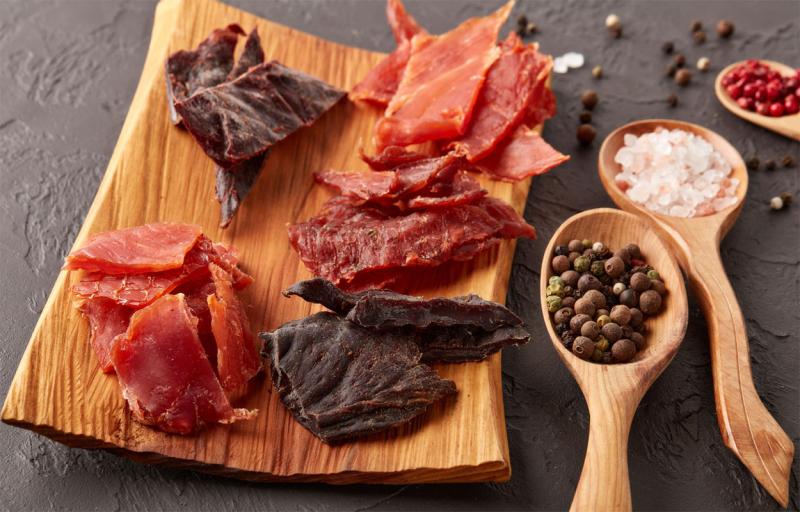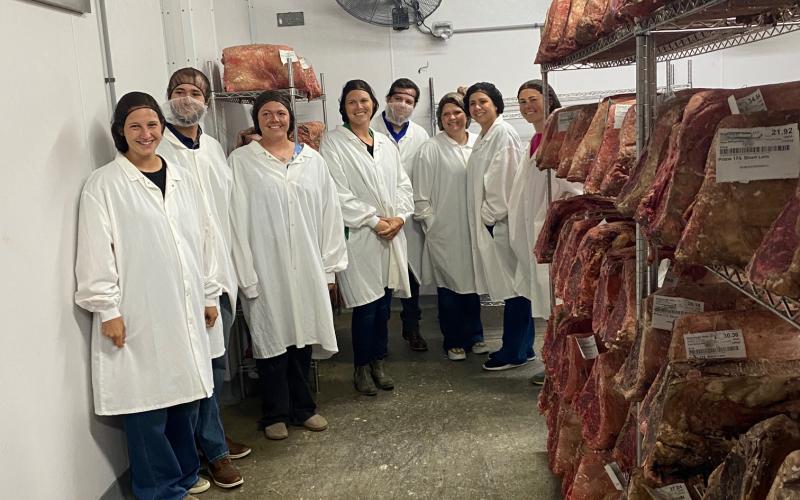Written by Abigail Lambert, SDSU Extension Food Preservation Intern, under the direction and review of Curtis Braun, SDSU Extension Food Safety Field Specialist.
Have excess meat left over from hunting season? Making jerky is a great way to enjoy it for months to come. Jerky requires no refrigeration and can be made from any lean meat, such as beef, pork, bison and venison.
Meat Safety

It’s important to handle raw meat safely in order to prevent the growth of harmful bacteria, which can easily multiply in moist protein foods. Before using pork or wild game to make jerky, it must be treated to kill trichinella parasites, which can cause trichinosis, a serious foodborne illness. To treat, freeze a 6-inch or less thick portion of meat at 0 degrees Fahrenheit or lower for at least 30 days.
Note: Freezing meat will not eliminate bacteria from meat.
Reduce the exposure and growth of bacteria by:
- Practicing good hygiene and washing hands thoroughly with soap and water for at least 30 seconds before and after handling meat.
- Clean and sanitize equipment and utensils before and after each use.
- Keep meat at the proper temperature of 40 degrees Fahrenheit or below.
- Use refrigerated poultry within 2 days and red meats within 3 to 5 days.
- Never thaw meat on the counter. Instead, thaw in the refrigerator.
- Marinate meat in the refrigerator and do not reuse marinades.
Butchering at Home
The wound location can compromise the safety of wild game meat. If the intestines of the animal are punctured during the hunt or butchering process, fecal bacteria can come in contact with the meat. Avoid using any meat that came in contact with intestine contents for jerky, as it will not be cooked at the appropriate temperature to eliminate harmful bacteria.

As an added safety measure against the risk of foodborne illness in home-dried jerky, it’s recommended to heat the meat until the internal temperature reaches 160 degrees Fahrenheit. This can be done before drying by boiling the meat in its marinade for 5 minutes or after drying by placing the dehydrated meat in an oven for 10 minutes at 275 degrees Fahrenheit. Directions for both methods are below. Color and texture will be different from traditional jerky.
Making Jerky
Preparing Meat
- Slice meat no thicker than ¼ inch (slice with grain for chewy jerky, with grain for tender and brittle).
- Trim fat and gristle off meat, as it can increase the rate of rancidity.
- Marinate meat in the refrigerator using oil, salt, spices and acidic ingredients (soy sauce, citrus juice, soy sauce or wine) for 1 to 12 hours. Marinating meat will increase its tenderness and flavor.
- Optional: Bring strips and marinade to a boil for 5 minutes before draining and drying to reduce risk of foodborne illness.
*Tip: Partially frozen meat makes slicing easier!

Dehydrating Meat
If using a dehydrator:
- Drain meat strips from marinade on clean paper towels.
- Place strips on dehydrating trays, making sure they are close but not touching.
- Insert the trays and start the dehydrator.
- The jerky is ready when it is firm and cracks, but doesn’t break when bent. For jerky heated in marinade beforehand, the estimated dehydrating time is 4 to 5 hours. Begin checking at hour three. For non-heated jerky, the estimated dehydrating time is 10 to 24 hours.
- When the dehydrating process is complete, remove strips from racks and allow to cool before packaging in glass jars, plastic food storage bags, or vacuum sealed packages.
*Jerky that wasn’t heated prior to marinade can be heated after dehydrating as a safety precaution. After drying, place strips on a baking sheet and heat 10 minutes in an oven at 275 degrees Fahrenheit.
If using an oven:
- Drain meat strips from marinade on clean paper towels.
- Place strips on cake racks over baking sheets.
- Insert the trays in oven preheated to 140 degrees Fahrenheit. Leave the oven door propped using a wooden spoon to allow moisture to escape.
- The jerky is ready when it is firm and cracks, but doesn’t break when bent. For jerky heated in marinade beforehand, the estimated dehydrating time is 4 to 5 hours. Begin checking at hour three. For nonheated jerky, the estimated dehydrating time is 10 to 24 hours.
- When the dehydrating process is complete, remove strips from racks and allow to cool before packaging in glass jars, plastic food storage bags, or vacuum-sealed packages.
*Jerky that wasn’t heated prior to marinade can be heated after dehydrating as a safety precaution. After drying, place strips on a baking sheet and heat 10 minutes in an oven at 275 degrees F.
Storage
Dried jerky can be stored at room temperature for 1-2 months in a sealed container or frozen for up to 6 months.
References
- Black, C. (2020). Venison Jerky – Dehydrating Meat: Tips, Safety, & Recipe.
- National Center for Home Food Preservation (2014). Drying Jerky.


